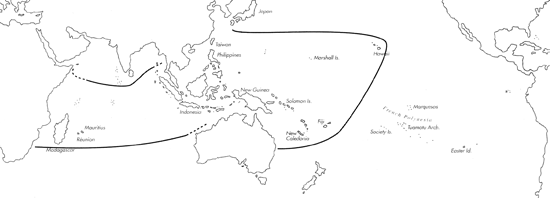
Skip Navigation Links
View access keys for this site.

Range: Natal and Mozambique to Hawaii.
Description: Medium-sized to moderately large, moderately solid to solid. Last whorl conical or ventricosely conical; outline convex at adapical fourth to half, less so or straight below. Shoulder angulate. Spire of low to moderate height, outline concave. Early postnuclear whorls weakly tuberculate. Teleoconch sutural ramps flat to slightly concave with 1 increasing to 3-4 spiral grooves, occasionally obsolete on late ramps. Last whorl with smooth and granulose spiral ribs near base to two-thirds and spiral rows of punctations above; granulose ribs with several smooth ribs between, primarily toward base.
| Shell Morphometry | ||
|---|---|---|
| L | 40-75 mm | |
| RW | 0.19-0.63 g/mm | |
| ((L 35-57 mm)) | ||
| RD | 0.58-0.63 | |
| PMD | 0.80-0.93 | |
| RSH | 0.04-0.14 | |
Ground colour white, variably suffused with violet. Last whorl with a broad yellowish tan to brown spiral band on each side of centre; colour bands variably wide, solid or interrupted, sometimes covering most of last whorl. Widely spaced spiral rows of brown dots and dashes from base to shoulder, varying from pronounced to obsolete and from numerous to absent. Base and siphonal fasciole purple. Larval whorls light brown. Teleoconch sutural ramps with brown radial streaks, occasionally extending to subshoulder area. Aperture white except for purple anterior end; occasionally with a violet marginal band to shoulder and exhalent notch.
Periostracum light brown, moderately thin, partially translucent, with axial and tufted spiral ridges on last whorl (Philippines; New Caledonia). In Hawaii, periostracum yellowish brown, rather thick and opaque in subadult specimens, becoming slightly translucent and yellow during further growth (Kohn, 1959a).
Marginal parts of foot pale lemon yellow, with sparse brown markings dorsally, larger on posterior parts. Siphon pale yellow, with a brown distal edge and a brown half-ring 1/3 the length from the tip (Hawaii, New Caledonia; Kohn & Weaver, 1962, Estival, unpubl. observ.).
Habitat and Habits: Usually in 10-240 m, down to 600 m in Hawaii; on sand, sand mixed with rubble, or on coralline gravel, either in semi-sheltered habitats or exposed to strong tidal currents (Cernohorsky, 1964; Estival, 1981; Estival & v. Cosel, 1986; Tirard, pers. comm., 1989; Grosch, pers. comm., 1989).
Discussion: The closest relative of C. circumactus is C. swainsoni from New Caledonia; for comparison see the DISCUSSION of that species. C. circumactus also resembles C. ferrugineus, C. planorbis and C. striatellus. All of these species differ from C. circumactus in lacking violet in their background colouration. The anterior end of the aperture is dark violet-brown in C. planorbis, white in C. ferrugineus and C. striatellus but purple to light violet brown in C. circumactus. C. striatellus moreover differs in having closely spaced spiral lines on the last whorl. These three species occur in intertidal and usually shallower subtidal habitats. For distinction between C. circumactus and C. rawaiensis see DISCUSSION of the latter species. Estival and Cosel (1986) considered C. connectens A. Adams, 1855 an earlier name for C. circumactus. Coomans et al, (1985a) considered the type specimen of C. connectens indeterminable, but Röckel (1988b) concluded that it is a specimen of C. daucus Hwass from the Western Atlantic. In any case it seems not to be an earlier name for C. circumactus. Coomans et al. (1985a) separate this species into C. circumactus s.s. and C. hammatus (Pl. 22, Fig. 7), but these two forms intergrade in colour pattern, shape and sculpture in both Indian and Pacific Ocean populations (Estival & v. Cosel, 1986). In agreement with Estival & v. Cosel (1986) we consider C. hammatus to apply to deep-water shells of C. circumactus, although this requires further study. Indian Ocean specimens of C. circumactus are more uniformly coloured than most shells from the Pacific Ocean and often have the late sutural ramps more concave and with weaker spiral sculpture.

C. circumactus range map
This section contains verbatim reproductions of the accounts of 316 species of Conus from the Indo-Pacific region, from Manual of the Living Conidae, by Röckel, Korn and Kohn (1995). They are reproduced with the kind permission of the present publisher, Conchbooks.
All plates and figures referred to in the text are also in Röckel, Korn & Kohn, 1995. Manual of the Living Conidae Vol. 1: Indo-Pacific Region.
The range maps have been modified so that each species account has it own map, rather than one map that showed the ranges of several species in the original work. This was necessary because each species account is on a separate page on the website and not confined to the order of accounts in the book.
Return to framed version (returns to search page)